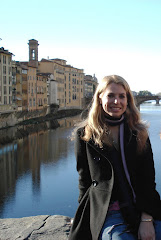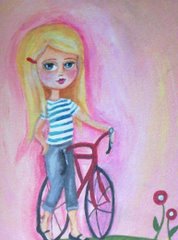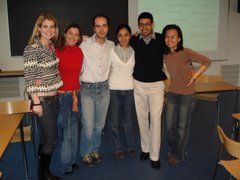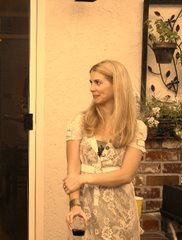
One of my beloved weekend rituals in Denmark is a ride up the coast of Sjælland on my 10-speed Dutch bicycle. This not-too-strenuous workout fuses three of my favorite activities: sight-seeing, day dreaming and exercise.
On these bike rides I think about nothing and everything. I’ve solved all the world’s problems a few times over (too bad I didn’t have a pen and paper handy). I think about my charmingly Marxist university, and the irony in them embracing with open arms my heartless republican ways. Sometimes, when a bug flies in my eye, I ponder why it is I’ve never been able to wink. After years of trying, I’m convinced it’s a genetic trait that, sadly, some are born without, much like being able to roll the tongue into a burrito or properly pronounce the Danish dessert rødgrød med fløde.
Sometimes, I consider pressing global events, like the making of the last, littlest superpower on Earth—Denmark— and how it’s a microcosm for a perfect society with values, riches, culture, great pastries, high taxes, skilled workers, human rights and smartly dressed citizens. I call Denmark my pocket country, because it’s just so cute and wonderful, I want to put it in my pocket.
These are the musings that accompany me on the bike.
A couple weeks ago, on the heels of a promising Danish romance fizzling like a can of old Carlsberg, I found myself mashing the pedals along my normal route up the coast. Through the lively streets of Copenhagen, weaving in and out of blond men pushing baby carriages, I headed east 5 km toward the Øresund Sound, then north through the towns of Taarbæk and Humlebæk on a concrete bike path, smooth as glass, that runs parallel to the sea. The Øresund strait is the body of water that separates Denmark and Sweden, the Nordic name for the mingling of the North and Baltic Seas that hosted legendary battles centuries ago between pillaging explorers in funny hats. It was a blustery day, two weeks ago, as I peered out into the foaming sea and imagined Hans Christian Andersen staring into the same space a century and a half earlier. His Little Mermaid lingering beneath the navy-blue water was an image dangling in my mind, safely encased in a bike helmet two sizes too small for me.
Some days — particularly when I’m bothered by some major or minor injustice, or plagued with a hangover — I pedal my bike with an overly excited vigor that would look bizarre to the innocent bystander. I probably resemble a full-grown Napoleon Dynamite, who is still pissed off at the world. Those days are rare, however, as life in Copenhagen gives me precious little to fret about.
But that day, I was upset. And sad. And I didn’t know why—or at least, I thought I didn’t— which upset me further. You know that feeling you get when you haven’t cried in the longest time, and you peer inside yourself and marvel at your strong, vibrant interior—coated in deep colors and textures of wool and steel? And you reach across your shoulder, and give yourself a proverbial pat on the back, for being so impressively strong? You know, sensations like that? In that moment, riding the bike, I made my escape into that tough-girl daydream.
But I didn’t get far. Peering across the Sound at Sweden to the north — a land where deadpan Vikings ferment their emotions into congealed ale — I noticed a tear leak from the corner of my eye, still caked with day-old mascara. I put my head down, embarrassed.
As the rain began to pour, I looked up to the sky and thanked whomever for not letting me cry alone. Denmark is a country where (when sober) everyone is preoccupied with the issue of embarrassment. I’m picking up on that tendency to a degree. But that day, somebody saved me from such a fate, and wasn’t going to let me be the weeping, pink-wearing American Napoleon Dynamite, pedaling toward Sweden, but going nowhere fast.
I cried freely with heaving sobs. The salty mist conspired with the rain to tangle my hair, swinging in a long ponytail down my back. Looking inland, I let go of the handlebars to crane my neck in sight of the one white house I needed to spot. A stately mansion on a hill across from the ocean in Charlottenlund is the U.S. Ambassador’s residence, where the Stars & Stripes fly, adding primary colors to a gray skyline. It is the only spot in Denmark permitted to fly the American flag. It is a fixture of vast mystical proportions for a homesick girl on a rainy day… in a land filled with shy, tall heartbreakers uncertain how to receive her.
I tried and I tried, but I couldn’t find the Ambassador’s home. It wasn’t in front of me, and it wasn’t behind me. With each pull on the pedals, each grating swing of my knobby knees, I bobbed my head forwards and backwards, grasping for some sign of life. I needed something to straighten my spine, to salute the tears out of my body like a squeegee scraping on glass.
The absence of the flag made my emotions unravel further, until my breathless moans were whittled down to a whimper, which became a hiccup of laughter. I pedaled on the edge of my passions, between joy and sorrow, between two nations, until the cry became a giggle, and the giggle became a sore stomach. I deserted my search and gazed at the road in front of me, with side-splitting hysterics navigating a crooked path. An old man in his church suit pedaled in my direction, with a wet dog perched in a basket over his front wheel. I winked at the old man, the only way an American girl who can’t wink can.
I had blinked my last tear. He spun past me, attending to an inner-debate in his mind that lasted an instant and ended with a faint smile over his shoulder, directly at me. Behind him, I spotted my old friend. The American flag soared in the sky, but there was no rain above it. The clouds parted, and a weary sun peeked from behind a canopy of gray that had been in place all winter long.
I call it Denmark’s winter filter that turns bright shades to gray and the moods of an entire population to ash. Soon, in the spring, the filter would fade away, and pale people would emerge from their houses, euphoric.
Seeing all there was to see, I turned for home. On the ride back, I thought about mermaids and Swedish astronauts… and the hard-earned smile from a stranger. I thought about the chipped fortress around my heart… and polished European men and women sipping lattés with their lovers... and all that tricky sunshine.
Sometimes, on rainy days, on bicycles, the world becomes a little clearer. If only you could take that clarity home with you, inside your pocket.
 It’s weird when a guy breaks up with you and you’re not even his girlfriend. “Sorry, Lars. I mean … Lasse… didn’t realize we were in a relationship?” seems such a lame response.
It’s weird when a guy breaks up with you and you’re not even his girlfriend. “Sorry, Lars. I mean … Lasse… didn’t realize we were in a relationship?” seems such a lame response.



















